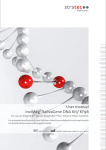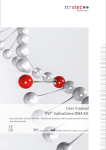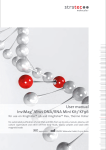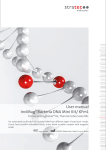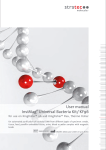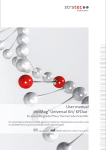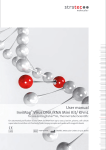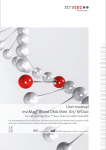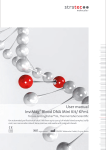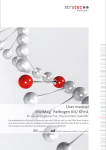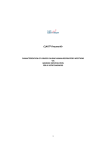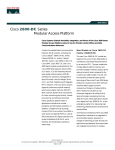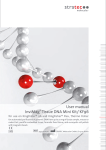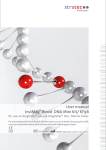Download InviMag SalivaGene DNA Kit/ KFmL User manual
Transcript
User manual InviMag® SalivaGene DNA Kit/ KFmL for use on KingFisher®mL, Thermo Fisher Scientific for automated purification of total DNA from SalivaGene stabilized clinical swab (mouth brushes) & saliva sample with magnetic beads REF 2435160X00 STRATEC Molecular GmbH, D-13125 Berlin Instruction for InviMag® SalivaGene DNA Kit/ KFmL The InviMag® SalivaGene DNA Kit/ KFmL is used to stabilize and purify human and/or bacterial genomic DNA quantitatively by use of magnetic beads on the KingFisher® mL instrument. The InviMag® SalivaGene DNA Kit/ KFmL is a modular system using a stabilization solution for collection, stabilization, storage and transportation of saliva material without degradation of DNA for at least 12 month with a very efficient isolation method for high quality DNA. The kit is neither suitable for the isolation of DNA from stool samples, fungi nor for purification of total RNA. Trademarks: InviMag®, SalivaGene®, Invisorb®, PSP®. Registered marks, trademarks, etc. used in this document, even when not specifically marked as such, are not to be considered unprotected by law. The Invisorb® technology is covered by patents and patent applications: US 6,110363, US 6,043,354, US 6,037,465, EP 0880535, WO 9728171, WO 9534569, EP 0765335, DE 19506887, DE 10041825.2, WO 0034463. InviMag®, SalivaGene®, Invisorb® and PSP® are registered trademarks of STRATEC Biomedical AG. The PCR process is covered by US Patents 4,683,195, and 4,683,202 and foreign equivalents owned by Hoffmann-La Roche AG. © 2015 STRATEC Molecular, all rights reserved. 1 InviMag SalivaGene DNA Kit /KFmL 0615 Contents Kit content of the InviMag® SalivaGene DNA Kit/ KFmL 3 Kit content of the InviMag® SalivaGene DNA Kit/ KFmL / w/o plastic 4 Content of SalivaGene® Stabilization Sets 5 Symbols 5 Storage 5 Quality control 6 ® Intended use of the InviMag SalivaGene DNA Kit/ KFmL 6 Product use limitation 6 Safety information 7 Product characteristic of the PSP® SalivaGene DNA Kit /KFmL 8 Sampling and sample storage 9 Principle and procedure 9 Yield and quality of DNA 9 Important points before starting a protocol 10 Preparing reagents and buffers 10 Reagents and equipment to be supplied by user 11 PSP®-Treatment with SalivaGene® Collection Module II 12 PSP®-Treatment of SalivaGene® Buccal Swab 13 Scheme for KingFisher mL instrument 14 Protocol I: Human DNA extraction from stabilized material 15 Protocol II: Bacterial DNA extraction from stabilized material 16 For self programming of the KFmL instrument 17 Troubleshooting 19 Appendix 20 General notes on handling DNA 21 Ordering information 22 2 InviMag SalivaGene DNA Kit /KFmL 0615 Kit content of the InviMag® SalivaGene DNA Kit/ KFmL Store dissolved Proteinase K and Lysozyme at -20°C! Store all other kit components at room temperature (RT)! 15 extractions 75 extractions 300 extractions 2435160100 2435160200 2435160400 for 500 µl working solution for 2 x 1 ml working solution for 7 ml working solution Binding Buffer A 4 x 1 ml (ready to use) 9 ml (final volume 30 ml) 24 ml (final volume 80 ml) MAP Solution B 0.5 ml 2 x 1 ml 7 ml for 500 µl working solution for 2 ml working solution for 7 ml working solution Catalogue No. Lysozyme Proteinase K Wash Buffer I 7,5 ml 30 ml 80 ml (final volume 15 ml) (final volume 60 ml) (final volume 160 ml) 18 ml 2 x 18 ml 2 x 60 ml (final volume 60 ml) (final volume 2 x 60 ml) (final volume 2 x 200 ml) 2 ml 30 ml 80 ml KingFisher mL Tip Combs 3 15 4 x 15 KingFisher mL Tube Strips 15 5 x 15 20 x 15 1.5 ml Receiver Tubes 15 5 x 15 20 x 15 Manual 1 1 1 Add 21 ml 99.7% Isopropanol to the Binding Buffer A. Mix by intensive shaking by inverting for 1 min. Shortly before use mix by inverting several times. Add 56 ml 99.7% Isopropanol to the Binding Buffer A. Mix by intensive shaking by inverting for 1 min. Shortly before use mix by inverting several times. Add 2 ml ddH2O to the tube with Proteinase K, mix thoroughly until completely dissolving and store at 20°C! Add 7 ml ddH2O to the tube with Proteinase K, mix thoroughly until completely dissolving and store at 20°C! Wash Buffer II Elution Buffer Initial steps Add 500 µl ddH2O to the tube with Proteinase K, mix thoroughly until completely dissolving and store at -20°C! Add 500 µl ddH2O to the tube with Lysozyme mix thoroughly and store the tube at -20°C! Add 7.5 ml of 96-100% ethanol to the bottle Wash Buffer I, mix thoroughly Add 1 ml ddH2O to each and store with tightly closed tube with Lysozyme, mix cap. thoroughly and store the tube at -20°C! Add 42 ml of 96-100% ethanol to each bottle Add 30 ml of 96-100% Wash Buffer II, mix ethanol to the bottle Wash thoroughly and store with Buffer I, mix thoroughly tightly closed cap. and store with tightly closed cap. Add 42 ml of 96-100% ethanol to each bottle Wash Buffer II, mix thoroughly and store with tightly closed cap. 3 Add 7 ml ddH2O to the tube with Lysozyme, mix thoroughly and store the tube at -20°C! Add 80 ml of 96-100% ethanol to the bottle Wash Buffer I, mix thoroughly and store with tightly closed cap. Add 140 ml of 96-100% ethanol to each bottle Wash Buffer II, mix thoroughly and store with tightly closed cap. InviMag SalivaGene DNA Kit /KFmL 0615 Kit content of the InviMag® SalivaGene DNA Kit/ KFmL / w/o plastic Store dissolved Proteinase K and Lysozyme at -20°C! Store all other kit components at room temperature (RT)! 15 extractions 75 extractions 300 extractions 2435160150 2435160250 2435160450 for 500 µl working solution 4 x 1 ml (ready to use) for 2 x 1 ml working solution 9 ml (final volume 30 ml) for 7 ml working solution 24 ml (final volume 80 ml) 0.5 ml 2 x 1 ml 7 ml for 500 µl working solution 7,5 ml for 2 ml working solution 30 ml for 7 ml working solution 80 ml (final volume 15 ml) (final volume 60 ml) (final volume 160 ml) 18 ml 2 x 18 ml 2 x 60 ml (final volume 60 ml) (final volume 2 x 60 ml) (final volume 2 x 200 ml) 2 ml 30 ml 80 ml for 500 µl working solution for 2 x 1 ml working solution for 2 x 1 ml working solution 500 µl 2 x 1 ml 2 x 1 ml 1.5 ml Receiver Tubes 15 5 x 15 20 x 15 Manual 1 1 1 Add 21 ml 99.7% Isopropanol to the Binding Buffer A. Mix by intensive shaking by inverting for 1 min. Shortly before use mix by inverting several times. Add 56 ml 99.7% Isopropanol to the Binding Buffer A. Mix by intensive shaking by inverting for 1 min. Shortly before use mix by inverting several times. Catalogue No. Lysozyme Binding Buffer A MAP Solution B Proteinase K Wash Buffer I Wash Buffer II Elution Buffer Lysozyme MAP B Initial steps Add 500 µl ddH2O to the tube with Proteinase K, mix thoroughly until completely dissolving and store at -20°C! Add 500 µl ddH2O to the tube with Lysozyme mix thoroughly and store the tube at -20°C! Add 2 ml ddH2O to the tube with Proteinase K, mix Add 7.5 ml of 96-100% ethanol thoroughly until completely to the bottle Wash Buffer I, mix dissolving and store at -20°C! thoroughly and store with tightly Add 1 ml ddH2O to each tube closed cap. with Lysozyme, mix thoroughly and store the tube Add 42 ml of 96-100% ethanol at -20°C! to each bottle Wash Buffer II, mix thoroughly and store with Add 30 ml of 96-100% ethanol tightly closed cap. to the bottle Wash Buffer I, Add 56 ml 98 -100% Isopropanol to the Binding Buffer A. Mix by intensive shaking by inverting for 1 min. Shortly before use mix by inverting several times. Add 7 ml ddH2O to the tube with Proteinase K, mix thoroughly until completely dissolving and store at -20°C! mix thoroughly and store with tightly closed cap. Add 7 ml ddH2O to the tube with Lysozyme, mix thoroughly and store the tube at -20°C! Add 42 ml of 96-100% ethanol to each bottle Wash Buffer II, mix thoroughly and store with tightly closed cap. Add 80 ml of 96-100% ethanol to the bottle Wash Buffer I, mix thoroughly and store with tightly closed cap. Add 140 ml of 96-100% ethanol to each bottle Wash Buffer II, mix thoroughly and store with tightly closed cap. Plastic to be supplied by user (see order information) KingFisher mL Tip Combs 3 15 4 x 15 KingFisher mL Tube Strips 15 5 x 15 20 x 15 4 InviMag SalivaGene DNA Kit /KFmL 0615 Content of SalivaGene® Stabilization Sets Collection Sets ® SalivaGene Collection Module II 5 sets 50 sets 1035210600 1035210700 5 pieces 50 pieces 5 pieces 50 pieces 5 pieces 50 pieces 1035230100 1035230200 5 pieces 50 pieces 5 pieces 50 pieces ® DNA Stabilizer (2 ml SalivaGene DNA Stabilizer) prefilled in a Transport Tube ® SalivaGene Collection Tube, provided as Set ® SalivaGene Swab Collection Tube prefilled with DNA Stabilizer (500 µl SalivaGene DNA Stabilizer) ® SalivaGene Buccal Swab Buccal Swabs ® SalivaGene Swab Collection Tube prefilled with DNA Stabilizer (500 µl SalivaGene DNA Stabilizer) Symbols Manufacturer Lot number Catalogue number Expiry date Consult operating instructions Temperature limitation Do not reuse Storage All buffers and kit components, except the dissolved Proteinase K and the Lysozyme of the InviMag® SalivaGene DNA Kit/ KFmL should be stored sealed and dry at room temperature and are stable for at least 12 months under these conditions. Dissolved Proteinase K and Lysozyme must be stored at -20°C. Repeated freezing and thawing cycles will reduce the activity of Proteinase K and Lysozyme dramatically. Dividing of dissolved Proteinase K and Lysozyme into aliquots and storage at -20°C is recommended. Wash Buffer I and II charged with ethanol should be appropriate sealed and stored at room temperature. The MAP B (magnetic beads) should be stored at 2-8°C. Before use make sure that all components have room temperature. If any precipitates are visible within the provided solutions solve them by carefully warming up to 30°C. Room temperature (RT) is defined as range from 15-30°C. 5 InviMag SalivaGene DNA Kit /KFmL 0615 Quality control and product warranty STRATEC Molecular warrants the correct function of the InviMag® SalivaGene DNA Kit/ KFmL for applications as described in this manual. Purchaser must determine the suitability of the product for its particular use. Should any product fail to perform the applications as described in the manual, STRATEC Molecular will check the lot and if STRATEC Molecular investigates a problem in the lot, STRATEC Molecular will replace the product free of charge. STRATEC Molecular reserves the right to change, alter, or modify any product to enhance its performance and design at any time. In accordance with STRATEC Molecular’s ISO 9001-2000 and ISO EN 13485 certified Quality Management System the performance of all components of the InviMag® SalivaGene DNA Kit/ KFmL have been tested separately against predetermined specifications routinely on lot-to-lot to ensure consistent product quality. If you have any questions or problems regarding any aspects of InviMag® SalivaGene DNA Kit/ KFmL or other STRATEC Molecular products, please do not hesitate to contact us. A copy of STRATEC Molecular’s terms and conditions can be obtained upon request or are presented at the STRATEC Molecular webpage. For technical support or further information please contact: from Germany +49-(0)30-9489-2901/ 2910 from abroad +49-(0)30-9489-2907 or contact your local distributor. Intended use The InviMag® SalivaGene DNA Kit/ KFmL is suitable for reproducible purification of total DNA from up to 500 µl stabilization media of saliva samples in forensic, human-identity, genetic, biosecurity and pathogen analyses. The purification is very efficient and the isolated DNA performs well in downstream applications, such as quantitative PCR and STR analysis, with high signal-to-noise ratios. The system consists of two modules, one collection set and one extraction module, useable independently or in combination. THE PRODUCT IS INDENTED FOR USE BY PROFESSIONALS ONLY, SUCH AS TECHNICIANS, PHYSICIANS AND BIOLOGISTS TRAINED IN MOLECULAR BIOLOGICAL TECHNIQUES. It is designed to be used with any downstream application employing enzymatic amplification or other enzymatic modifications of DNA followed by signal detection or amplification. Any diagnostic results generated by using the sample preparation procedure in conjunction with any downstream diagnostic assay should be interpreted with regard to other clinical or laboratory findings. To minimize irregularities in diagnostic results, adequate controls for downstream applications should be used. Product use limitation The kit is neither validated for the isolation of genomic DNA from serum, plasma, fungi, parasites nor for the isolation and purification of total RNA. The included chemicals are only useable once. Differing of starting material or flow trace may lead to inoperability; therefore neither a warranty nor guarantee in this case will be given, neither implied nor express. The user is responsible to validate the performance of the STRATEC Molecular product for any particular use. STRATEC Molecular does not provide for validation of performance characteristics of the product with respect to specific applications. STRATEC Molecular products may be used e.g.in clinical diagnostic laboratory systems conditioned upon the complete diagnostic system of the laboratory the laboratory has been validated pursuant to CLIA’ 88 regulations in the U.S. or equivalents in other countries. 6 InviMag SalivaGene DNA Kit /KFmL 0615 All products sold by STRATEC Molecular are subject to extensive quality control procedures (according to ISO 9001-2000 and ISO EN 13485) and are warranted to perform as described herein. Any problems, incidents or defects shall be reported to STRATEC Molecular immediately upon detection thereof. The chemicals and the plastic parts are for laboratory use only; they must be stored in the laboratory and must not be used for purposes other than intended. The product with its contents is unfit for consumption. Safety information When and while working with chemicals, always wear a suitable lab coat, disposable gloves, and protective goggles! Avoid skin contact! Adhere to the legal requirements for working with biological material! For more information, please consult the appropriate material safety data sheets (MSDS). These are available online in convenient and compact PDF format at www.stratec.com for each STRATEC Molecular product and its components. If buffer bottles are damaged or leaking, WEAR GLOVES, AND PROTECTIVE GOGGLES when discarding the bottles in order to avoid any injuries. STRATEC Molecular has not tested the liquid waste generated by the InviMag® SalivaGene DNA Kit/ KFmL procedures for residual infectious materials. Contamination of the liquid waste with residual infectious materials is highly unlikely, but cannot be excluded completely. Therefore, liquid waste must be considered infectious and be handled and discarded according to local safety regulations. European Community risk and safety phrases for the components of the InviMag® SalivaGene DNA Kit/ KFmL to which they apply, are listed below as follows: Wash Buffer I warning H302-312-332-412 EU032 P273 Proteinase K: SalivaGene® DNA Stabilizer danger H315-319-334-335 P280-305-351-338-310-405 danger H319 P305-351-338 H319: H302: H312: H319: H332: H412: EUH032: H315: H334: H335: P305+P351+P338: P273: P280: P310: P405: Causes serious eye irritation. Harmful if swallowed. Harmful in contact with skin. Causes serious eye irritation Harmful if inhaled. Harmful to aquatic life with long lasting effects. Contact with acids liberates very toxic gas. Causes skin irritation. May cause allergy or asthma symptoms or breathing difficulties if inhaled. May cause respiratory irritation. If in eyes: Rinse cautiously with water for several minutes. Remove contact lenses, if present and easy to do. Continue rinsing. Avoid release to the environment. Wear protective gloves/protective clothing/eye protection/face protection. Immediately call a POISON CENTER or doctor/physician. Store locked up. Emergency medical information can be obtained 24 hours a day from infotrac: outside of USA: in USA : 1 – 352 – 323 – 3500 1 – 800 – 535 – 5053 7 InviMag SalivaGene DNA Kit /KFmL 0615 Product characteristic of the PSP® SalivaGene DNA Kit /KFmL Starting material Yield Time Ratio 500 µl of stabilization buffer (SalivaGene DNA Stabilizer) saliva mix 1:1 up to 10 µg (depends on kind of starting material) 23 min (without lysis) A260 : A 280 1.7 – 2.0 The InviMag® SalivaGene DNA Kit/ KFmL uses the PSP® Technology (Preanalytical-SampleProcessing) a patented cost efficient technology and is a modular designed system for collection, stabilization, storage and transportation of saliva samples with DNA purification. The system combines the use of a prefilled SalivaGene® Collection Tube for saliva sample collection, the storage and stabilization of saliva specimen without any degradation of the DNA during transportation, including the prelysis of bacteria and a very efficient and fast isolation (about 23 min) of high quality total DNA from up to 500 µl mixture using the KFmL instrument. The kit is designed for isolation of DNA from host organism as well as for isolation of DNA from pathogen microorganisms. After sample collection, the saliva sample is transferred in the SalivaGene® Collection Tube prefilled with SalivaGene® DNA Stabilizer. The raw material is lysed under these specific conditions. The SalivaGene® DNA Stabilizer causes an inactivation of DNases and thereby prevents the degradation of DNA, preserves the microorganism titer and prelyses bacteria. The transport of the stabilized DNA can be carried out in the SalivaGene® DNA Stabilizer containing tubes without cooling during 6 weeks at ambient temperature. The sample can also be stored in this buffer at -20°C for a long-term storage. For the DNA extraction process, an aliquot or the whole volume is used. The residual sample can be stored and used for further extractions. A 500 µl aliquot of the stabilized sample is used in the PSP® SalivaGene DNA isolation procedure. At first, the proteins are degraded with Proteinase K, followed by a binding of the DNA to magnetic beads while contaminants, like potent inhibitors and proteins are rejected and washed-out, leaving the pure DNA to be eluted in either water or the buffer provided within the kit. For reproducible and high yields appropriate sample storage is essential. Yields may be varying from sample to sample depending on factors such as the health of the donor, patient medication or sample storage conditions. The procedure neither requires a phenol / chloroform extraction nor an alcohol precipitation. Furthermore, the kit requires only minimal interaction by the user, allowing safe handling of potentially infectious samples. The procedure is designed to prevent sample-to-sample crosscontaminations. Due to the high purity, the isolated genomic DNA is ready to use for a broad panel of downstream applications (see below) or can be stored at –20°C for subsequent use. ○ ○ ○ ○ PCR*, Real Time PCR Analysis*, RFLP / AFLP*- Analysis Restriction Enzyme Digestion HLA-Typing Pathogen Detection *) The PCR method is covered by U.S. Patents 4,683,195 and 4,683,202 owned by Hoffmann-LaRoche Inc. The purchase of the InviMag® SalivaGene DNA Kit/ KFmL cannot be construed as an authorization or implicit license to practice PCR under any patents held by Hoffmann-LaRoche Inc. 8 InviMag SalivaGene DNA Kit /KFmL 0615 Sampling and sample storage Starting material The amount of starting material used in InviMag® SalivaGene DNA Kit/ KFmL procedure can vary slightly, depending on the amount of DNA present in the sample. Specific guidance for starting amounts is given in the individual protocols. The protocol works with aliquots of the transport media, in which fresh saliva samples are collected. The DNA in SalivaGene® stabilized samples is stable for 1 year at room temperature within the expiry date.The aliquots of the stabilization buffer may be processed on the same day as collection or stored for future processing. For long-term storage store the sample at -20°C. STRATEC Molecular will be released of its responsibilities if other sample materials than described in the Intended Use are processed or if the sample preparation protocols are changed or modified. Principle and procedure The InviMag® SalivaGene DNA Kit/ KFmL procedure comprises the following steps: ○ Collection of the material using a SalivaGene® Collection Set ○ Lysis under non-chaotropic conditions at elevated temperature in Stabilization Buffer (SalivaGene® DNA Stabilizer) ○ Protein digestion (Proteinase K) ○ Binding of the genomic DNA to magnetic beads (MAP B) ○ Washing of the beads and elimination of contaminants and ethanol ○ Elution of pure genomic DNA This manual contains 2 protocols, according to the different requirements of the starting materials used. Lysis Samples are lysed under non-chaotropic conditions at elevated temperature in the Stabilization Buffer (SalivaGene® DNA Stabilizer). Protein digestion Proteins will be digested in the lysed samples in the presence of Proteinase K. Binding genomic DNA By adding Binding Buffer A to the lysate, optimal binding conditions are adjusted. Each lysate is then applied to magnetic beads and the genomic DNA is bound to the beads. Removing residual contaminations Contaminants are efficiently washed away using Wash Buffer I and II, while the genomic, mitochondrial and bacterial DNA remains bound to the magnetic beads. Elution of pure genomic DNA The isolated DNA is eluted from the magnetic beads using Elution Buffer and can be used in different downstream applications. Yield and quality of DNA The amount of purified DNA in the InviMag® SalivaGene DNA Kit/ KFmL procedure from different samples depends on the sample type, sample source, transport, storage and age. Yield and quality of isolated DNA are suitable for any molecular-diagnostic detection system. The diagnostic tests should be performed accordingly to the manufacturer’s specifications. 9 InviMag SalivaGene DNA Kit /KFmL 0615 Important points before starting a protocol General handling notes Immediately upon receipt of the product, inspect the product and its components as well as the package for any apparent damages, correct quantities and quality. If there are any unconformities you have to notify STRATEC Molecular in writing with immediate effect upon inspection thereof. If buffer bottles are damaged, contact the STRATEC Molecular Technical Services or your local distributor. In case of liquid spillage, refer to “Safety Information” (see page 7). Do not use damaged kit components, since their use may lead to poor kit performance. ○ ○ ○ ○ ○ ○ ○ Always change pipette tips between liquid transfers. To avoid cross-contaminations, we recommend the use of aerosol-barrier pipette tips. When working with chemicals, always wear a suitable lab coat, disposable gloves and protective goggles. Discard contaminated gloves immediately. Do not combine components of different kits, unless the lot numbers are identical. Avoid microbial contamination of the kit reagents. To minimize the risk of infections from potentially infectious material, we recommend working under laminar airflow until the samples are lysed. This kit should only be used by trained personnel. Preparing reagents and buffers Before starting a run, equilibrate all reagents to room temperature. Where necessary, gently mix and redissolve any precipitates by warming up to 30°C. Swirl gently to avoid foaming. 1. Add the needed amount of ddH2O to reaction tube with Proteinase K (see below). Vortex for 5 s. Repeat this step for the Lysozyme using Lysozyme Buffer. 2. Add the needed amount of ethanol to Wash Buffer I and Wash Buffer II If a KFmL instrument is used for isolation the protein digestion has to be done on an additional themocycler: Adjust a thermomixer to 56°C (human sample). If bacterial DNA should be isolated a previous incubation step at 37°C is needed. 15 DNA extractions: Add 500 µl ddH2O to the tube with Proteinase K, mix thoroughly until completely dissolving and store at -20°C! Add 500 µl ddH2O to the tube with Lysozyme mix thoroughly and store the tube at -20°C! Add 7.5 ml of 96-100% ethanol to the bottle Wash Buffer I, mix thoroughly and store with tightly closed cap. Add 42 ml of 96-100% ethanol to each bottle Wash Buffer II, mix thoroughly and store with tightly closed cap 75 DNA extractions: Add 21 ml 99.7% Isopropanol to the Binding Buffer A. Mix by intensive shaking by inverting for 1 min. Shortly before use mix by inverting several times. Add 2 ml ddH2O to the tube with Proteinase K, mix thoroughly until completely dissolving and store at -20°C! Add 1 ml ddH2O to each tube with Lysozyme, mix thoroughly and store the tube at -20°C! Add 30 ml of 96-100% ethanol to the bottle Wash Buffer I, mix thoroughly and store with tightly closed cap. Add 42 ml of 96-100% ethanol to each bottle Wash Buffer II, mix thoroughly and store with tightly closed cap. 300 DNA extractions: Add 56 ml 99.7% Isopropanol to the Binding Buffer A. Mix by intensive shaking by inverting for 1 min. Shortly before use mix by inverting several times. Add 7 ml ddH2O to the tube with Proteinase K, mix thoroughly until completely dissolving and store at -20°C! Add 7 ml ddH2O to the tube with Lysozyme, mix thoroughly and store the tube at -20°C! Add 80 ml of 96-100% ethanol to the bottle Wash Buffer I, mix thoroughly and store with tightly closed cap. Add 140 ml of 96-100% ethanol to each bottle Wash Buffer II, mix thoroughly and store with tightly closed cap 10 InviMag SalivaGene DNA Kit /KFmL 0615 Reagents and equipment to be supplied by user When working with chemicals, always wear a suitable lab coat, disposable gloves, and protective goggles. For more information, please consult the appropriate material safety data sheets (MSDS). These are available online in convenient and compact PDF format at www.stratec.com under each STRATEC Molecular kit and kit component. ○ ○ ○ ○ ○ ○ ○ ○ ○ Thermomixer (56°C (human, bacteria), 37°C (bacteria only)) Measuring cylinder (250 ml) Disposable gloves Pipette and pipette tips Vortexer ddH2O 96-100% ethanol 1.5 ml reaction tube(s) Isopropanol *The InviMag® SalivaGene DNA Kit/ KFmL is validated with 2-Propanol; Rotipuran >99.7%, p.a., ACS, ISO (Order no. 6752) from Carl Roth * Possible suppliers for Isopropanol: Fa. Carl Roth 2-Propanol Rotipuran >99.7%, p.a., ACS, ISO Order no. 6752 Fa. Applichem 2-Propanol für die Molekularbiologie Order no. A3928 11 Fa. Sigma 2-Propanol Order no. 59304-1L-F InviMag SalivaGene DNA Kit /KFmL 0615 PSP®-Treatment with SalivaGene® Collection Module II Intended Use: Collection of human saliva samples for DNA stabilization and extraction (using the SalivaGene DNA Extraction Kits). The DNA in SalivaGene stabilized samples is stable for 1 year at room temperature within the expiry date. The product is intended for use under supervision of professionals only, such as technicians, physicians and biologist trained in molecular biological techniques. Contents: Collection tube, Stabilizer tube. The stabilizer tube contains approx. 2 ml of liquid Saliva DNA Stabilizer reagent. Limitations of the procedure: Do not eat, drink, smoke or chew gum at least 30 min prior to saliva collection. Collecting 2 ml of saliva may require several minutes. Putting some grains of sugar on the tongue helps to produce saliva and does not interfere with the stabilization. Unscrew lid from Collection Tube and put it aside for further use. Rub cheeks against teeth intensely for 30 sec. Collect saliva to indicated fill level, avoid making and measuring air bubbles. Unscrew and discard lid from Stabilizer Tube. Pour Saliva DNA Stabilizer reagent into Collection Tube. Screw lid tightly onto the Collection Tube again. Shake tube for 15 sec to mix saliva and Saliva DNA Stabilizer reagent. 12 InviMag SalivaGene DNA Kit /KFmL 0615 PSP-Treatment of SalivaGene® Buccal Swab Intended Use: Collection of human oral samples for DNA stabilization and extraction (using the SalivaGene DNA Extraction Kits). The DNA in SalivaGene stabilized samples is stable for 1 year at room temperature within the expiry date. The product is intended for use under supervision of professionals only, such as technicians, physicians and biologist trained in molecular biological techniques. Contents: Swab, Stabilizer tube, label for donor description. The Stabilizer tube contains approx. 2 ml of liquid DNA Stabilizer reagent. Limitations of the procedure: Do not eat, drink, smoke or chew gum at least 30 min prior to swab collection. Ensure the swab tip does not come into contact with any surface prior to collection. Put the Stabilizer tube upright to prevent the liquid inside the tube from spilling. Be sure to move the swab over the entire cheek and to moisten it with saliva. Open swab package and remove swab without touching the tip. Insert swab into the mouth and rub swab tip firmly against the inner cheeks for about 30 seconds on each side. Unscrew lid from Stabilizer tube and put it aside for further use. Insert swab into the Stabilizer tube. Break swab tip at breaking point. Discard the broken handle part. Screw lid tightly onto the Stabilizer tube again. Gently shake tube for 15 sec to mix buccal cells and DNA Stabilizer reagent. Label Stabilizer tube with donor name and collection date using provided label. 13 InviMag SalivaGene DNA Kit /KFmL 0615 Scheme of the InviMag® SalivaGene DNA Kit/ KFmL Please carefully read protocols prior starting with the preparation Transfer 500 µl stabilized sample into a 1.5 ml reaction tube and add the appropriate lysis reagent (PK and/or Lysozyme, see (1a) or (1b) During lysis, prefill the Tube Stripes with the needed buffers as described below. Add 200 µl Binding Buffer A (follow preparing instructions) and Binding Tube A: 20 µl MAP B Washing Tube B: Add 500 µl Wash Buffer I Washing Tube C: Add 600 µl Wash Buffer II Washing Tube D: Add 600 µl Wash Buffer II Elution Tube E: Add 200 µl Elution Buffer (1a) Bacterial DNA: Transfer 500 µl stabilized sample into a 1.5 ml reaction tube and add 20 µl Lysozyme. Incubate for 10 min at 37°C while continuously shaking. Afterwards add 20 µl Proteinase K and incubate for 20 min at 56°C while continuously shaking. Continue with step (2) of the manual. During lysis, prefill all Tube Stripes with required buffers and appropriate volumes. (1b) Human DNA: Transfer 500 µl stabilized sample into a 1.5 ml reaction tube, add 20 µl Proteinase K and incubate for 20 min at 56°C while continuously shaking. Continue with step (2). During lysis, prefill all Tube Stripes with required buffers and appropriate volumes. (2) After the lysis step, transfer the whole sample from step (1a) or (1b) into the Tube Stripe A (containing 200 µl Binding Buffer A and 20 µl MAP B) and select the program “InviMag Salivagene DNA KFmL” DNA binds to magnetic particles Magnetic separation Washing of the particle fixed genomic DNA Magnetic separation Elution of genomic DNA Magnetic Separation Pure DNA 14 InviMag SalivaGene DNA Kit /KFmL 0615 Protocol I: Human DNA extraction from stabilized material Please read the instructions carefully and conduct the prepared procedure. Attention: Please be aware, that you have to prepare the Binding Buffer A – see instruction page: 10 Lysis (external) Transfer 500 µl of Saliva / DNA Stabilizing Mixture from the SalivaGene® Collection Tube into a 1.5 ml reaction tube (not provided). Add 20 µl of Proteinase K and incubate for 20 min at 56°C while continuously shaking or alternatively flick the tube every 5 min. Note: If you have to archive a SalivaGene sample, e.g. for forensic purposes, store the residual sample not needed for preparation at -20°C. The sample is stable for several years under these conditions. Prepare the Tube Stripes with the appropriate buffers and volumes needed during the lysis process (see below for detailed information). During lysis, prepare the Tube Stripes with the provided buffers and appropriate volumes. See below for detailed information. Important: Mix the bottle with the MAP B by vigorously vortexing! Tube Stripe A: Tube Stripe B: Tube Stripe C: Tube Stripe D: Tube Stripe E: Transfer 200 µl Binding Buffer A and 20 µl MAP B into Tube Stripe A Transfer 500 µl Wash Buffer I Transfer 600 µl Wash Buffer II Transfer 600 µl Wash Buffer II Transfer 200 µl Elution Buffer Starting a run After lysis, transfer the lysed sample into the Tube Stripe A containing 200 µl Binding Buffer A and 20 µl MAP B. Start the purification by selecting the assay file “InviMag Salivagene DNA KFmL” and press the “START” button. The DNA will bind to the magnetic beads and will then be transported through the different washing solutions before the elution will take place in Tube Stripe E. The eluate can finally be transferred into the provided Receiver Tubes. 15 InviMag SalivaGene DNA Kit /KFmL 0615 Protocol II: Bacterial DNA extraction from stabilized material Please read the instructions carefully and conduct the prepared procedure. Attention: Please be aware, that you have to prepare the Binding Buffer A – see instruction page: 10 Lysis (external) Transfer 500 µl Saliva / DNA Stabilizing Mixture from the SalivaGene® Collection Tube into a 1.5 ml reaction tube (not provided). Add 20 µl of Lysozyme, vortex for 5 s and incubate the mixture for 10 min at 37°C while continuously shaking or flicking the tube from time to time. Afterwards add 20 µl Proteinase K and incubate for an additional 20 min at 56°C while continuously shaking or every 5 minutes flicking the tube. Note: If you have to archive a SalivaGene sample, e.g. for forensic purposes, just freeze the rest you don’t use for preparation. The rest of the stabilized sample can be stored at –20°C for years. During lysis, prepare the Tube Stripes with the provided buffers and appropriate volumes. See below for detailed information. Important: Mix the bottle with the MAP B by vigorously vortexing! Tube Stripe A: Tube Stripe B: Tube Stripe C: Tube Stripe D: Tube Stripe E: Transfer 200 µl Binding Buffer A and 20 µl MAP B into Tube Stripe A Transfer 500 µl Wash Buffer I Transfer 600 µl Wash Buffer II Transfer 600 µl Wash Buffer II Transfer 200 µl Elution Buffer Starting a run After lysis, transfer the lysed sample into the Tube Stripe A containing 200 µl Binding Buffer A and 20 µl MAP B. Start the protocol by selecting the assay file “InviMag Salivagene DNA KFmL” and press the “START” button. The DNA will bind to the magnetic beads and will be transported through the different washing buffers before the elution is performed in Tube Stripe E. The eluate can finally be transferred into the provided Receiver Tubes after the assay has been finished. 16 InviMag SalivaGene DNA Kit /KFmL 0615 For self programming of the KFmL instrument Beginning of step: Precollect: No Release time [hh:mm:ss]: 00:00:10 Release speed: Fast [Protocol Properties] Software Version: BindIt 3.1 Name = InviMag Salivagene DNA KFmL Protocol template version = 3.1 Instrument type = KingFisher mL Creator = STRATEC Molecular GmbH Description = KFmL protocol (Thermo Electron) for isolation of genomic, mitochondrial and/or bacterial DNA from saliva samples (human) stored in Saligene® Stabilization Tubes with InviMag® SalivaGene DNA Kit/ KFmL. Kit = InviMag® SalivaGene DNA Kit/ KFmL Mixing/pause parameters: Pause for manual handling: No Mixing time [hh:mm:ss]: 00:05:00 Mixing speed: Slow End of step: Postmix: No Collect count: 4 Collect time [s]: 3 Wash 1 (Plate: Salivagene (B) - Wash 1) [Layout Data] Beginning of step: Precollect: No Release time [hh:mm:ss]: 00:00:10 Release speed: Fast Tray/plate type: KingFisher tubestrip 1000 µl Tube A (Binding) Reagents: Name: Lysed Sample Volume [µl]: 520 Type: Sample Mixing/pause parameters: Pause for manual handling: No Mixing time [hh:mm:ss]: 00:01:30 Mixing speed: Medium Name: MAP B Volume [µl]: 20 Type: Reagent End of step: Postmix: No Collect count: 3 Collect time [s]: 2 Name: Binding Buffer A Volume [µl]: 200 Type: Reagent Wash 2 (Plate: Salivagene (C) - Wash 2) Beginning of step: Precollect: No Release time [hh:mm:ss]: 00:00:10 Release speed: Fast Tube B (Wash 1) Reagents: Name: Wash Buffer I Volume [µl]: 500 Type: Reagent Mixing/pause parameters: Pause for manual handling: No Mixing time [hh:mm:ss]: 00:01:00 Mixing speed: Medium Tube C (Wash 2) Reagents: Name: Wash Buffer II Volume [µl]: 600 Type: Reagent End of step: Postmix: No Collect count: 3 Collect time [s]: 2 Tube D (Wash 3) Reagents: Name: Wash Buffer II Volume [µl]: 600 Type: Reagent Wash 3 (Plate: Salivagene (D) - Wash 3) Beginning of step: Precollect: No Release time [hh:mm:ss]: 00:00:10 Release speed: Medium Tube E (Elution) Reagents: Name: Elution Buffer Volume [µl]: 200 Type: Reagent Mixing/pause parameters: Pause for manual handling: No Mixing time [hh:mm:ss]: 00:01:00 Mixing speed: Medium [Steps] Tip1: KingFisher ml tip comb End of step: Postmix: No Binding (Plate: Salivagene (A) – Binding) 17 InviMag SalivaGene DNA Kit /KFmL 0615 Collect count: 3 Collect time [s]: 2 Pause for manual handling: No Mixing time [hh:mm:ss]: 00:10:00 Mixing speed: Slow Drying (Plate: Salivagene (D) - Wash 3) Dry time [hh:mm:ss]: 00:03:30 Tip position: Outside well / tube End of step: Postmix: No Collect count: 4 Collect time [s]: 3 Elution Plate (Salivagene (E) – Elution) Beginning of step: Precollect: No Release time [hh:mm:ss]: 00:00:10 Release speed: Medium Bead Removal (Plate: Salivagene (D)-Wash3) Release time [hh:mm:ss]: 00:00:30 Release speed: Fast Mixing/pause parameters: 18 InviMag SalivaGene DNA Kit /KFmL 0615 Troubleshooting Problem Cause Comments and suggestions amount of DNA insufficient cell lysis due to decreased Proteinase K / Lysozyme activity repeat the DNA purification procedure with a new sample and freshly prepared Proteinase K / Lysozyme stock solution. be sure to make aliquots and store them at -20°C insufficient lysis due to insufficient mixing with ® lysis buffer - SalivaGene DNA Stabilizer repeat the DNA purification procedure with a new sample. Be ® sure to mix the sample and SalivaGene DNA Stabilizer immediately low percentage alcohol used repeat purification procedure with a new sample incomplete elution increase incubation time with Elution Buffer to 5-10 min or increase the elution volume to 200 µl. This will however reduce the final DNA concentration. Make sure to adjust modification in the KingFisher software pH of water incorrect (acidic) low pH may reduce DNA yield. Ensure that the pH of the water is at least 7.0 or use Elution Buffer (contains 10 mM Tris-HCl but no EDTA) degraded or sheared DNA incorrect storage of starting material ensure the sample is harvested and stored correctly old material avoid repeated thawing and freezing cycles of the material. Old samples often contain degraded DNA problems ethanol in the eluted DNA with subsequent applications salt in the eluate (e.g. in PCR) verify if the recommended dry time was reached increase drying time for the elimination of ethanol in the run file Wash Buffer should be stored and used at RT make sure that no precipitates are visible within the Washing Buffers. If any precipitations are visible, dissolve them by carefully warming up to 30°C reduced sensitivity of amplification adjust the volume of eluate added as template in the reaction amplification reaction A260/A280 ratio insufficient cell lysis and protein see above under “low amount of DNA” for purified degradation due to decreased DNA is low Proteinase K / Lysozyme activity insufficient lysis due to incomplete see above under “ low amount of DNA” mixing with lysis buffer 19 InviMag SalivaGene DNA Kit /KFmL 0615 Appendix KingFisher Software 3.1 The KingFisher Software 3.1 was used to create assay files for the KFmL, KF96 and KFflex96 instruments. The respective assay file can either be transferred onto the KingFisher workstation or be started directly from within the BindIt software. Keep in mind that directly run assay files are not stored in the workstation memory! Note: When creating assay files for usage with KingFisher instruments in combination with Microtiter Deep Well plates (e.g. Thermo Electron), it is essential to use the KingFisher software 3.1 for assay development as this software version includes the correct adjustments for this plate. It is highly recommended to use Thermo Microtiter Deep Well plates with KF96 / KFflex96 workstations to ensure the best purification result. PC requirements for KingFisher Software 3.1 PC requirements Interface Serial communication port via a RS-232 full duplex interface Supported operating systems Microsoft Windows 2000 Microsoft Windows XP Professional Disk space 500 MB free disk space Processor Intel Pentium ≥ 700 MHz recommended Memory 220 MB RAM recommended Serial ports available 1 Pointing device Mouse or equivalent is necessary CD-ROM drive 1 Monitor / color settings SVGA monitor with at least 1024 x 768 resolution and at least a 16-bit color environment Service packs installed Microsoft Windows 2000: Service Pack 4 (or greater) Microsoft Windows XP Professional: Service Pack 2 (or greater) Browser Microsoft Internet Explorer 6.0 (or greater) installed If you do not have the correct Service Packs installed, you can download them from the Microsoft web pages: http://www.microsoft.com/ 20 InviMag SalivaGene DNA Kit /KFmL 0615 General notes on handling DNA Starting material This kit is designed for extraction of DNA from saliva and swabs. These materials show big variation in DNA contents. The purification of some apoptotic DNA is normal. Nature of DNA The length and delicate physical nature of DNA requires careful handling to avoid damage due to shearing and enzymatic degradation. Other conditions that affect the integrity and stability of DNA include acidic and alkaline environments, high temperature, and UV irradiation. Careful isolation and handling of high molecular weight DNA is necessary to ensure compatibility with various downstream applications. Damaged DNA could perform poorly in applications such as genomic Southern blotting, and long-template PCR. Storage of DNA A working stock of DNA can be stored at 2 – 4˚C for several weeks. For long term storage DNA should be stored at - 20˚C, but storing at – 20°C can cause shearing, particularly if the DNA is exposed to repeated freeze-thaw cycles. Note that the solution in which the nucleic acid is eluted in will affect its stability during storage. Pure water lacks buffering capacity and an acidic pH may lead to acid hydrolysis. Tris or TrisEDTA buffer contains sufficient buffering capacity to prevent acid hydrolysis. Drying, dissolving and pipetting DNA Avoid over drying genomic DNA after ethanol precipitation. It is better to let it air dry than to use a vacuum, although vacuum drying can be used with caution. Avoid vigorous pipetting. Pipetting genomic DNA through small tip openings causes shearing or nicking. One way to decrease shearing of genomic DNA is to use special tips that have wide openings designed for pipetting genomic DNA. 21 InviMag SalivaGene DNA Kit /KFmL 0615 Ordering information Product Package size Catalogue No. InviMag® SalivaGene DNA Kit /KFmL InviMag® SalivaGene DNA Kit /KFmL InviMag® SalivaGene DNA Kit /KFmL 15 preps 75 preps 300 preps 2435160100 2435160200 2435160400 InviMag® SalivaGene DNA Kit /KF96 /KFflex 96 InviMag® SalivaGene DNA Kit /KF96 /KFflex 96 1x 96 preps 5x 96 preps 7435300100 7435300200 PSP® SalivaGene DNA Kit PSP® SalivaGene DNA Kit PSP® SalivaGene DNA Kit 5 preparations 50 preparations 250 preparations 1035200100 1035200200 1035200300 SalivaGene® Collection Module II SalivaGene® Collection Module II 5 container 50 container 1035210600 1035210700 SalivaGene® Buccal Swab SalivaGene® Buccal Swab 5 pieces 50 pieces 1035230100 1035230200 Ordering information (KingFisher mL and consumables from Thermo Scientific) Cat.no 5400050 97002111 97002121 97002131 97002141 Description KingFisher mL, Magnetic Particle Processor, 100-240 V, 50/60 Hz KingFisher mL tip comb, 800 pcs KingFisher mL tube, 900 pcs (20x45 pcs) KingFisher mL Combi 60 (tubes and tip combs for 60 samples) KingFisher mL Combi 240 (tubes and tip combs for 240 samples) Possible suppliers for Isopropanol: Fa. Carl Roth 2-Propanol Rotipuran >99.7%, p.a., ACS, ISO Order no. 6752 Fa. Applichem 2-Propanol für die Molekularbiologie Order no. A3928 22 Fa. Sigma 2-Propanol Order no. 59304-1L-F InviMag SalivaGene DNA Kit /KFmL 0615 STRATEC Molecular GmbH Robert-Rössle-Str. 10 13125 Berlin, Germany www.stratec.com 1G3g02/06/2015 Phone: +49 30 94 89 29 01 Fax: +49 30 94 89 29 09 E-mail: [email protected]
























